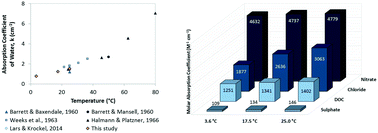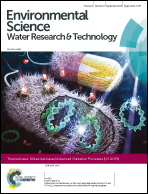Temperature dependence of the absorbance of 185 nm photons by water and commonly occurring solutes and its influence on the VUV advanced oxidation process†
Abstract
The 185 nm photon absorption properties of water and solutes, typically found in surface water, such as chloride, nitrate, sulphate and dissolved organic carbon (DOC) were studied at temperatures between 3.5 °C and 25.0 °C. Moreover, their impact on the degradation efficiency of a model micropollutant through vacuum UV (VUV) advanced oxidation process (AOP) was assessed at temperatures of 3.6 °C and 17.5 °C. For water, an absorption coefficient of 0.79 ± 0.11 cm−1 was obtained at 3.6 °C and it was observed to increase to 1.23 ± 0.09 cm−1 and 1.53 ± 0.08 cm−1 at 17.5 °C and 25.0 °C, respectively. Degradation experiments of atrazine (i.e., model micropollutant) in distilled water showed that there was a slight decrease in the degradation efficiency of the AOP as temperature increased from 3.6 °C to 17.5 °C. Of the solutes tested, nitrate showed the largest molar absorption coefficient, followed by chloride, DOC and sulphate. In addition, the molar absorption coefficient of chloride and sulphate showed substantial sensitivity to temperature while little to no temperature dependency was observed for that of DOC and nitrate, respectively. When surface water was used, a slightly larger removal of atrazine was observed at 17.5 °C in comparison that at 3.6 °C. This was attributed to the increase in 185 nm photons absorbed by water in relation to the other major species in the solution, thus improving the generation of OH radicals.

- This article is part of the themed collection: Ultraviolet-based Advanced Oxidation Processes (UV AOPs)

 Please wait while we load your content...
Please wait while we load your content...